Personal and Professional Development Report
VerifiedAdded on 2020/02/05
|13
|4244
|364
Report
AI Summary
This report emphasizes the significance of personal and professional development, detailing various self-managed learning approaches. It includes a comprehensive analysis of learning styles, benefits of self-managed learning, and the necessity for individual training. The report also outlines a personal development plan, assessing short and long-term objectives, and documenting planning activities to enhance skills in leadership, communication, and time management.
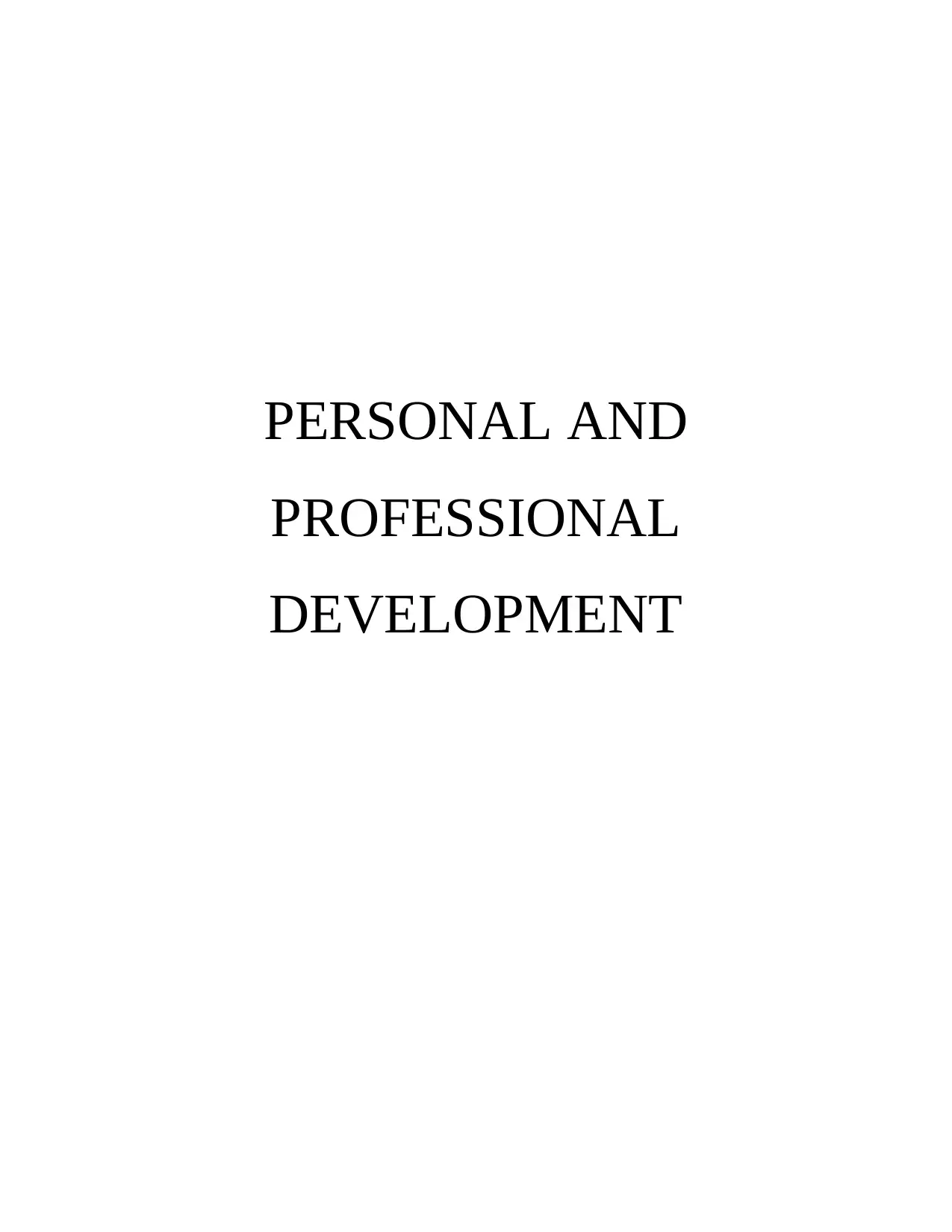
PERSONAL AND
PROFESSIONAL
DEVELOPMENT
PROFESSIONAL
DEVELOPMENT
Paraphrase This Document
Need a fresh take? Get an instant paraphrase of this document with our AI Paraphraser
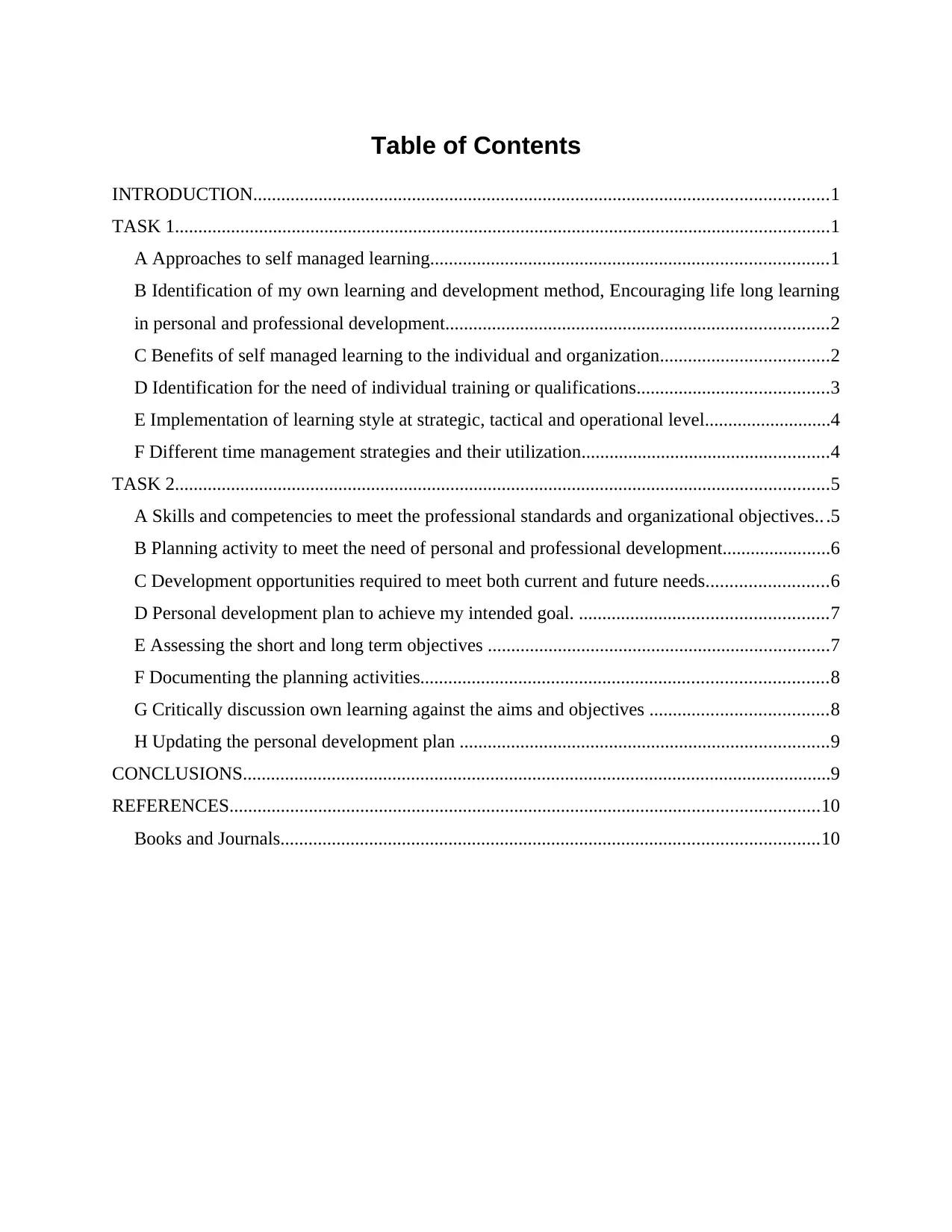
Table of Contents
INTRODUCTION...........................................................................................................................1
TASK 1............................................................................................................................................1
A Approaches to self managed learning.....................................................................................1
B Identification of my own learning and development method, Encouraging life long learning
in personal and professional development..................................................................................2
C Benefits of self managed learning to the individual and organization....................................2
D Identification for the need of individual training or qualifications.........................................3
E Implementation of learning style at strategic, tactical and operational level...........................4
F Different time management strategies and their utilization.....................................................4
TASK 2............................................................................................................................................5
A Skills and competencies to meet the professional standards and organizational objectives.. .5
B Planning activity to meet the need of personal and professional development.......................6
C Development opportunities required to meet both current and future needs..........................6
D Personal development plan to achieve my intended goal. .....................................................7
E Assessing the short and long term objectives .........................................................................7
F Documenting the planning activities.......................................................................................8
G Critically discussion own learning against the aims and objectives ......................................8
H Updating the personal development plan ...............................................................................9
CONCLUSIONS..............................................................................................................................9
REFERENCES..............................................................................................................................10
Books and Journals...................................................................................................................10
INTRODUCTION...........................................................................................................................1
TASK 1............................................................................................................................................1
A Approaches to self managed learning.....................................................................................1
B Identification of my own learning and development method, Encouraging life long learning
in personal and professional development..................................................................................2
C Benefits of self managed learning to the individual and organization....................................2
D Identification for the need of individual training or qualifications.........................................3
E Implementation of learning style at strategic, tactical and operational level...........................4
F Different time management strategies and their utilization.....................................................4
TASK 2............................................................................................................................................5
A Skills and competencies to meet the professional standards and organizational objectives.. .5
B Planning activity to meet the need of personal and professional development.......................6
C Development opportunities required to meet both current and future needs..........................6
D Personal development plan to achieve my intended goal. .....................................................7
E Assessing the short and long term objectives .........................................................................7
F Documenting the planning activities.......................................................................................8
G Critically discussion own learning against the aims and objectives ......................................8
H Updating the personal development plan ...............................................................................9
CONCLUSIONS..............................................................................................................................9
REFERENCES..............................................................................................................................10
Books and Journals...................................................................................................................10
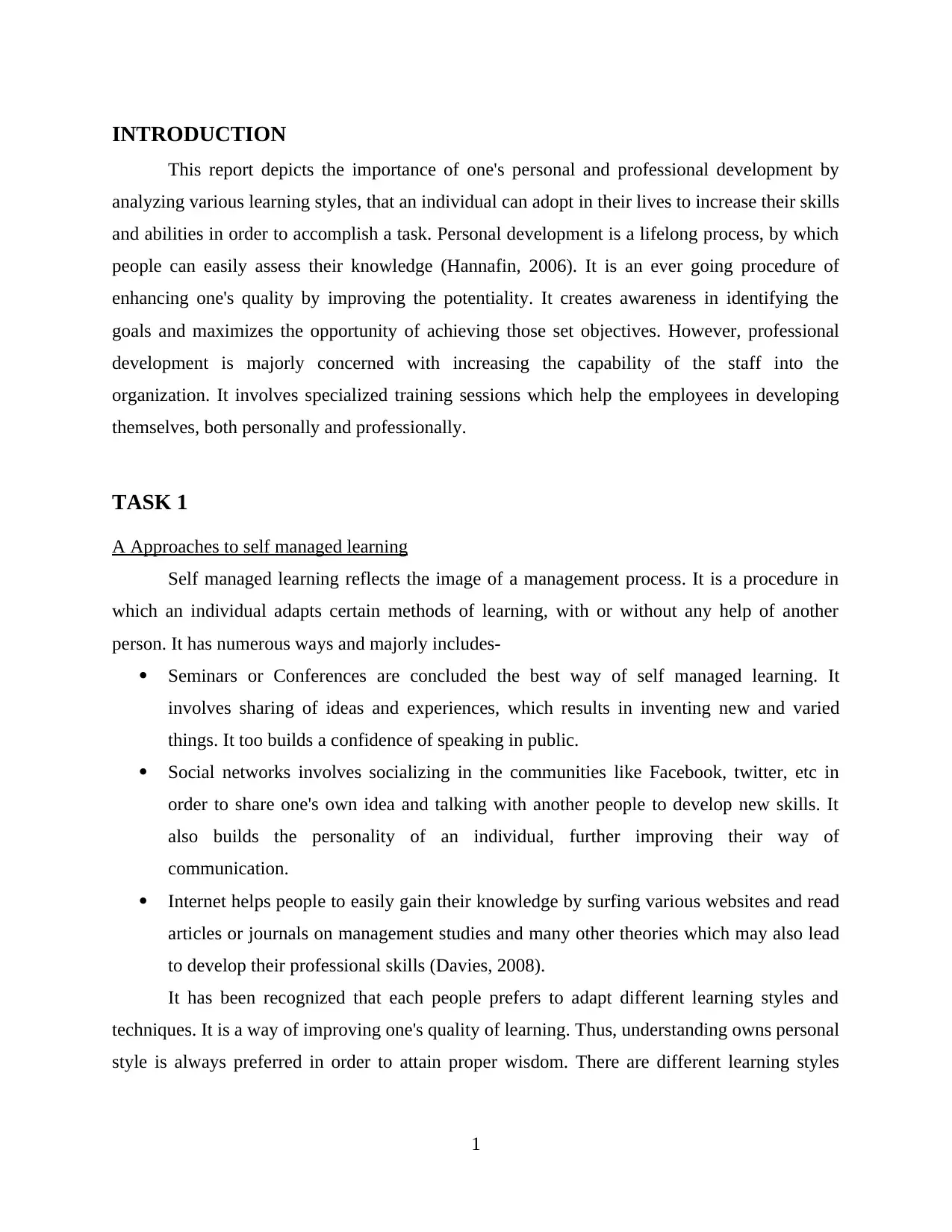
INTRODUCTION
This report depicts the importance of one's personal and professional development by
analyzing various learning styles, that an individual can adopt in their lives to increase their skills
and abilities in order to accomplish a task. Personal development is a lifelong process, by which
people can easily assess their knowledge (Hannafin, 2006). It is an ever going procedure of
enhancing one's quality by improving the potentiality. It creates awareness in identifying the
goals and maximizes the opportunity of achieving those set objectives. However, professional
development is majorly concerned with increasing the capability of the staff into the
organization. It involves specialized training sessions which help the employees in developing
themselves, both personally and professionally.
TASK 1
A Approaches to self managed learning
Self managed learning reflects the image of a management process. It is a procedure in
which an individual adapts certain methods of learning, with or without any help of another
person. It has numerous ways and majorly includes-
Seminars or Conferences are concluded the best way of self managed learning. It
involves sharing of ideas and experiences, which results in inventing new and varied
things. It too builds a confidence of speaking in public.
Social networks involves socializing in the communities like Facebook, twitter, etc in
order to share one's own idea and talking with another people to develop new skills. It
also builds the personality of an individual, further improving their way of
communication.
Internet helps people to easily gain their knowledge by surfing various websites and read
articles or journals on management studies and many other theories which may also lead
to develop their professional skills (Davies, 2008).
It has been recognized that each people prefers to adapt different learning styles and
techniques. It is a way of improving one's quality of learning. Thus, understanding owns personal
style is always preferred in order to attain proper wisdom. There are different learning styles
1
This report depicts the importance of one's personal and professional development by
analyzing various learning styles, that an individual can adopt in their lives to increase their skills
and abilities in order to accomplish a task. Personal development is a lifelong process, by which
people can easily assess their knowledge (Hannafin, 2006). It is an ever going procedure of
enhancing one's quality by improving the potentiality. It creates awareness in identifying the
goals and maximizes the opportunity of achieving those set objectives. However, professional
development is majorly concerned with increasing the capability of the staff into the
organization. It involves specialized training sessions which help the employees in developing
themselves, both personally and professionally.
TASK 1
A Approaches to self managed learning
Self managed learning reflects the image of a management process. It is a procedure in
which an individual adapts certain methods of learning, with or without any help of another
person. It has numerous ways and majorly includes-
Seminars or Conferences are concluded the best way of self managed learning. It
involves sharing of ideas and experiences, which results in inventing new and varied
things. It too builds a confidence of speaking in public.
Social networks involves socializing in the communities like Facebook, twitter, etc in
order to share one's own idea and talking with another people to develop new skills. It
also builds the personality of an individual, further improving their way of
communication.
Internet helps people to easily gain their knowledge by surfing various websites and read
articles or journals on management studies and many other theories which may also lead
to develop their professional skills (Davies, 2008).
It has been recognized that each people prefers to adapt different learning styles and
techniques. It is a way of improving one's quality of learning. Thus, understanding owns personal
style is always preferred in order to attain proper wisdom. There are different learning styles
1
⊘ This is a preview!⊘
Do you want full access?
Subscribe today to unlock all pages.

Trusted by 1+ million students worldwide
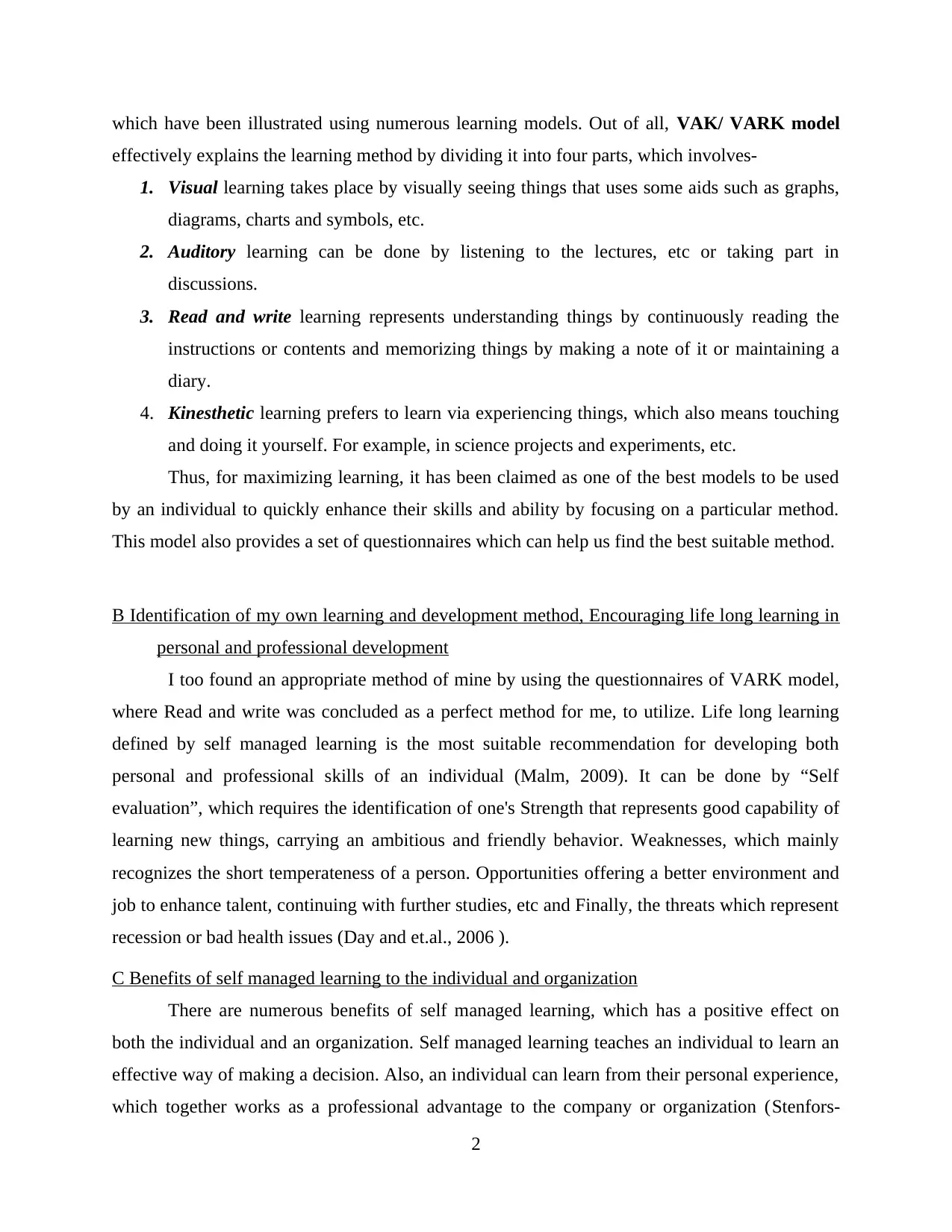
which have been illustrated using numerous learning models. Out of all, VAK/ VARK model
effectively explains the learning method by dividing it into four parts, which involves-
1. Visual learning takes place by visually seeing things that uses some aids such as graphs,
diagrams, charts and symbols, etc.
2. Auditory learning can be done by listening to the lectures, etc or taking part in
discussions.
3. Read and write learning represents understanding things by continuously reading the
instructions or contents and memorizing things by making a note of it or maintaining a
diary.
4. Kinesthetic learning prefers to learn via experiencing things, which also means touching
and doing it yourself. For example, in science projects and experiments, etc.
Thus, for maximizing learning, it has been claimed as one of the best models to be used
by an individual to quickly enhance their skills and ability by focusing on a particular method.
This model also provides a set of questionnaires which can help us find the best suitable method.
B Identification of my own learning and development method, Encouraging life long learning in
personal and professional development
I too found an appropriate method of mine by using the questionnaires of VARK model,
where Read and write was concluded as a perfect method for me, to utilize. Life long learning
defined by self managed learning is the most suitable recommendation for developing both
personal and professional skills of an individual (Malm, 2009). It can be done by “Self
evaluation”, which requires the identification of one's Strength that represents good capability of
learning new things, carrying an ambitious and friendly behavior. Weaknesses, which mainly
recognizes the short temperateness of a person. Opportunities offering a better environment and
job to enhance talent, continuing with further studies, etc and Finally, the threats which represent
recession or bad health issues (Day and et.al., 2006 ).
C Benefits of self managed learning to the individual and organization
There are numerous benefits of self managed learning, which has a positive effect on
both the individual and an organization. Self managed learning teaches an individual to learn an
effective way of making a decision. Also, an individual can learn from their personal experience,
which together works as a professional advantage to the company or organization (Stenfors-
2
effectively explains the learning method by dividing it into four parts, which involves-
1. Visual learning takes place by visually seeing things that uses some aids such as graphs,
diagrams, charts and symbols, etc.
2. Auditory learning can be done by listening to the lectures, etc or taking part in
discussions.
3. Read and write learning represents understanding things by continuously reading the
instructions or contents and memorizing things by making a note of it or maintaining a
diary.
4. Kinesthetic learning prefers to learn via experiencing things, which also means touching
and doing it yourself. For example, in science projects and experiments, etc.
Thus, for maximizing learning, it has been claimed as one of the best models to be used
by an individual to quickly enhance their skills and ability by focusing on a particular method.
This model also provides a set of questionnaires which can help us find the best suitable method.
B Identification of my own learning and development method, Encouraging life long learning in
personal and professional development
I too found an appropriate method of mine by using the questionnaires of VARK model,
where Read and write was concluded as a perfect method for me, to utilize. Life long learning
defined by self managed learning is the most suitable recommendation for developing both
personal and professional skills of an individual (Malm, 2009). It can be done by “Self
evaluation”, which requires the identification of one's Strength that represents good capability of
learning new things, carrying an ambitious and friendly behavior. Weaknesses, which mainly
recognizes the short temperateness of a person. Opportunities offering a better environment and
job to enhance talent, continuing with further studies, etc and Finally, the threats which represent
recession or bad health issues (Day and et.al., 2006 ).
C Benefits of self managed learning to the individual and organization
There are numerous benefits of self managed learning, which has a positive effect on
both the individual and an organization. Self managed learning teaches an individual to learn an
effective way of making a decision. Also, an individual can learn from their personal experience,
which together works as a professional advantage to the company or organization (Stenfors-
2
Paraphrase This Document
Need a fresh take? Get an instant paraphrase of this document with our AI Paraphraser
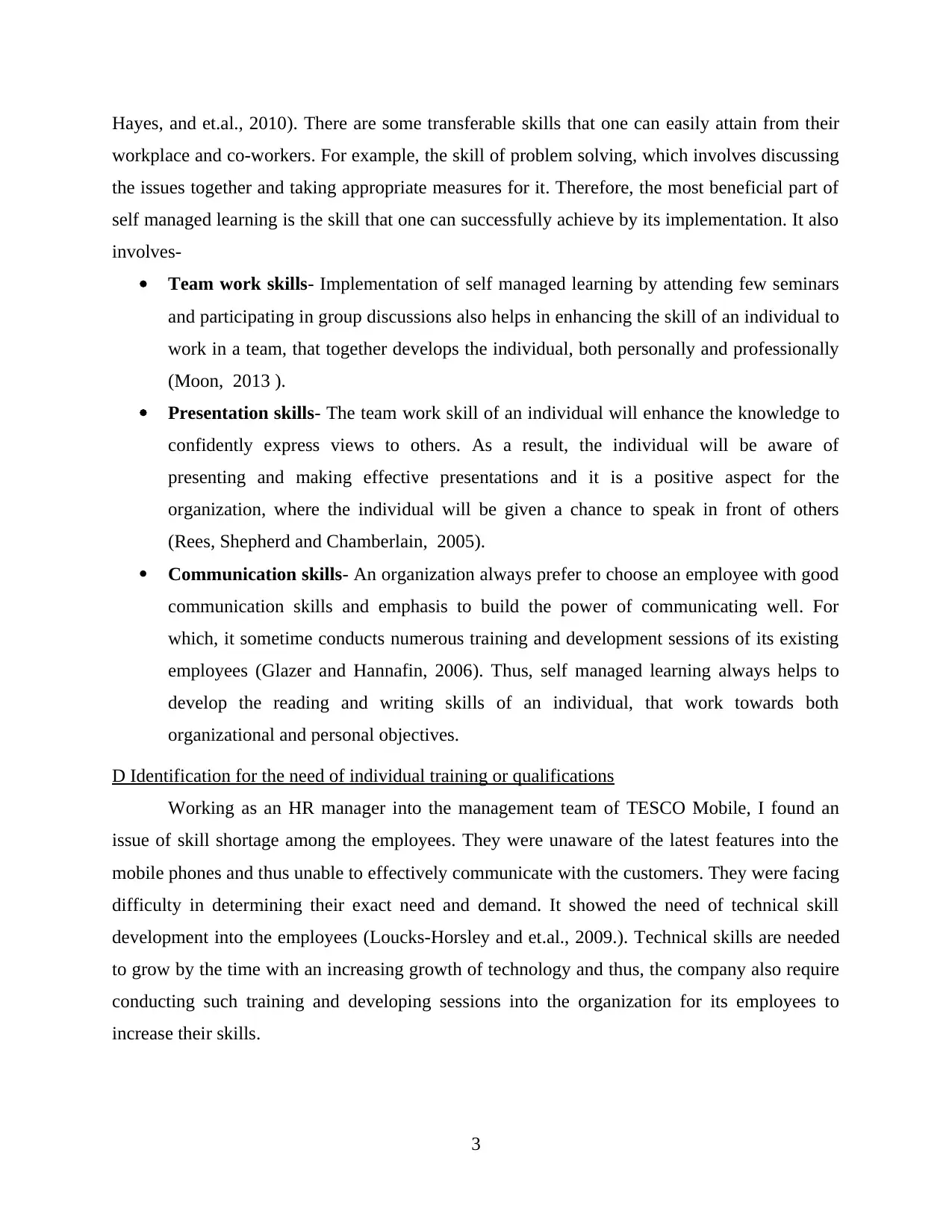
Hayes, and et.al., 2010). There are some transferable skills that one can easily attain from their
workplace and co-workers. For example, the skill of problem solving, which involves discussing
the issues together and taking appropriate measures for it. Therefore, the most beneficial part of
self managed learning is the skill that one can successfully achieve by its implementation. It also
involves-
Team work skills- Implementation of self managed learning by attending few seminars
and participating in group discussions also helps in enhancing the skill of an individual to
work in a team, that together develops the individual, both personally and professionally
(Moon, 2013 ).
Presentation skills- The team work skill of an individual will enhance the knowledge to
confidently express views to others. As a result, the individual will be aware of
presenting and making effective presentations and it is a positive aspect for the
organization, where the individual will be given a chance to speak in front of others
(Rees, Shepherd and Chamberlain, 2005).
Communication skills- An organization always prefer to choose an employee with good
communication skills and emphasis to build the power of communicating well. For
which, it sometime conducts numerous training and development sessions of its existing
employees (Glazer and Hannafin, 2006). Thus, self managed learning always helps to
develop the reading and writing skills of an individual, that work towards both
organizational and personal objectives.
D Identification for the need of individual training or qualifications
Working as an HR manager into the management team of TESCO Mobile, I found an
issue of skill shortage among the employees. They were unaware of the latest features into the
mobile phones and thus unable to effectively communicate with the customers. They were facing
difficulty in determining their exact need and demand. It showed the need of technical skill
development into the employees (Loucks-Horsley and et.al., 2009.). Technical skills are needed
to grow by the time with an increasing growth of technology and thus, the company also require
conducting such training and developing sessions into the organization for its employees to
increase their skills.
3
workplace and co-workers. For example, the skill of problem solving, which involves discussing
the issues together and taking appropriate measures for it. Therefore, the most beneficial part of
self managed learning is the skill that one can successfully achieve by its implementation. It also
involves-
Team work skills- Implementation of self managed learning by attending few seminars
and participating in group discussions also helps in enhancing the skill of an individual to
work in a team, that together develops the individual, both personally and professionally
(Moon, 2013 ).
Presentation skills- The team work skill of an individual will enhance the knowledge to
confidently express views to others. As a result, the individual will be aware of
presenting and making effective presentations and it is a positive aspect for the
organization, where the individual will be given a chance to speak in front of others
(Rees, Shepherd and Chamberlain, 2005).
Communication skills- An organization always prefer to choose an employee with good
communication skills and emphasis to build the power of communicating well. For
which, it sometime conducts numerous training and development sessions of its existing
employees (Glazer and Hannafin, 2006). Thus, self managed learning always helps to
develop the reading and writing skills of an individual, that work towards both
organizational and personal objectives.
D Identification for the need of individual training or qualifications
Working as an HR manager into the management team of TESCO Mobile, I found an
issue of skill shortage among the employees. They were unaware of the latest features into the
mobile phones and thus unable to effectively communicate with the customers. They were facing
difficulty in determining their exact need and demand. It showed the need of technical skill
development into the employees (Loucks-Horsley and et.al., 2009.). Technical skills are needed
to grow by the time with an increasing growth of technology and thus, the company also require
conducting such training and developing sessions into the organization for its employees to
increase their skills.
3
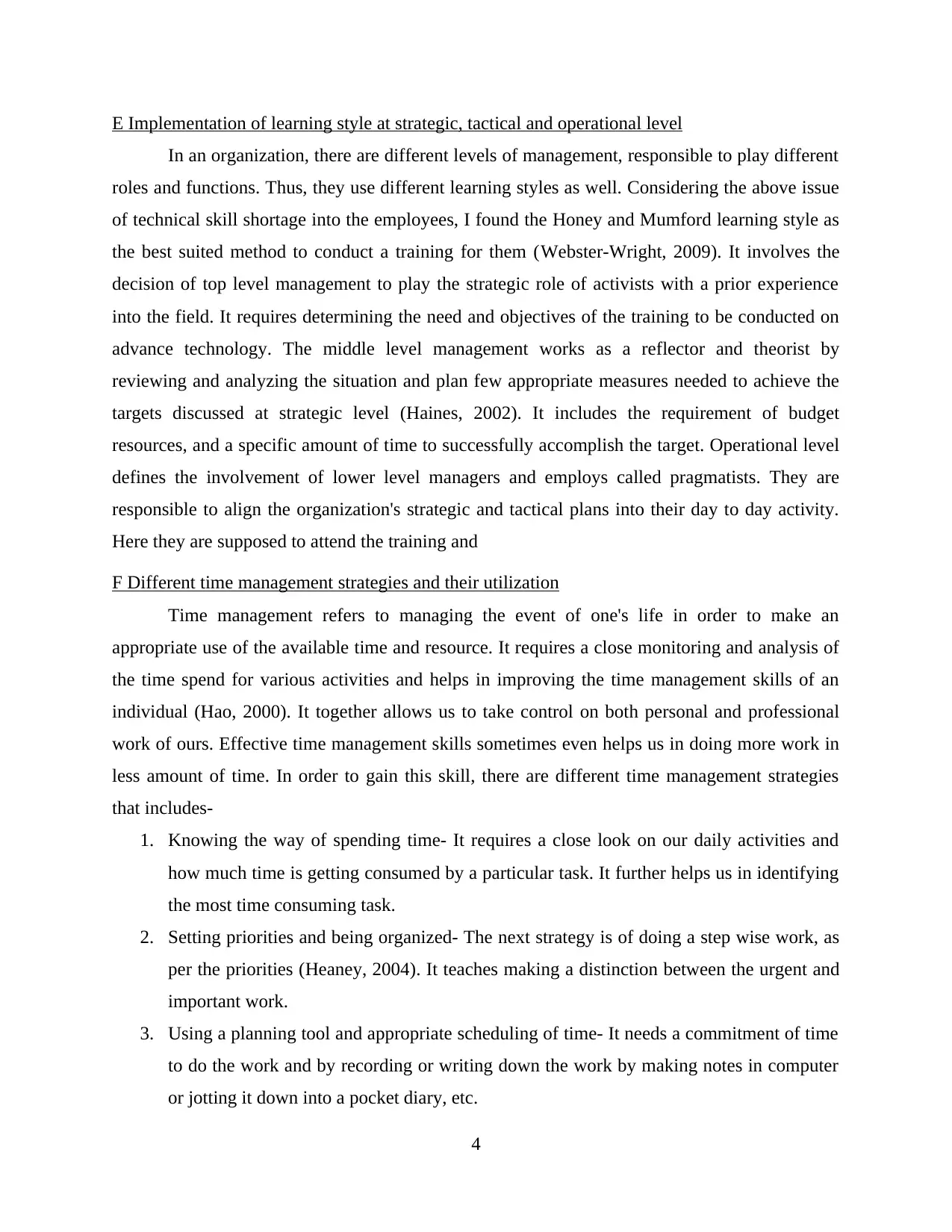
E Implementation of learning style at strategic, tactical and operational level
In an organization, there are different levels of management, responsible to play different
roles and functions. Thus, they use different learning styles as well. Considering the above issue
of technical skill shortage into the employees, I found the Honey and Mumford learning style as
the best suited method to conduct a training for them (Webster-Wright, 2009). It involves the
decision of top level management to play the strategic role of activists with a prior experience
into the field. It requires determining the need and objectives of the training to be conducted on
advance technology. The middle level management works as a reflector and theorist by
reviewing and analyzing the situation and plan few appropriate measures needed to achieve the
targets discussed at strategic level (Haines, 2002). It includes the requirement of budget
resources, and a specific amount of time to successfully accomplish the target. Operational level
defines the involvement of lower level managers and employs called pragmatists. They are
responsible to align the organization's strategic and tactical plans into their day to day activity.
Here they are supposed to attend the training and
F Different time management strategies and their utilization
Time management refers to managing the event of one's life in order to make an
appropriate use of the available time and resource. It requires a close monitoring and analysis of
the time spend for various activities and helps in improving the time management skills of an
individual (Hao, 2000). It together allows us to take control on both personal and professional
work of ours. Effective time management skills sometimes even helps us in doing more work in
less amount of time. In order to gain this skill, there are different time management strategies
that includes-
1. Knowing the way of spending time- It requires a close look on our daily activities and
how much time is getting consumed by a particular task. It further helps us in identifying
the most time consuming task.
2. Setting priorities and being organized- The next strategy is of doing a step wise work, as
per the priorities (Heaney, 2004). It teaches making a distinction between the urgent and
important work.
3. Using a planning tool and appropriate scheduling of time- It needs a commitment of time
to do the work and by recording or writing down the work by making notes in computer
or jotting it down into a pocket diary, etc.
4
In an organization, there are different levels of management, responsible to play different
roles and functions. Thus, they use different learning styles as well. Considering the above issue
of technical skill shortage into the employees, I found the Honey and Mumford learning style as
the best suited method to conduct a training for them (Webster-Wright, 2009). It involves the
decision of top level management to play the strategic role of activists with a prior experience
into the field. It requires determining the need and objectives of the training to be conducted on
advance technology. The middle level management works as a reflector and theorist by
reviewing and analyzing the situation and plan few appropriate measures needed to achieve the
targets discussed at strategic level (Haines, 2002). It includes the requirement of budget
resources, and a specific amount of time to successfully accomplish the target. Operational level
defines the involvement of lower level managers and employs called pragmatists. They are
responsible to align the organization's strategic and tactical plans into their day to day activity.
Here they are supposed to attend the training and
F Different time management strategies and their utilization
Time management refers to managing the event of one's life in order to make an
appropriate use of the available time and resource. It requires a close monitoring and analysis of
the time spend for various activities and helps in improving the time management skills of an
individual (Hao, 2000). It together allows us to take control on both personal and professional
work of ours. Effective time management skills sometimes even helps us in doing more work in
less amount of time. In order to gain this skill, there are different time management strategies
that includes-
1. Knowing the way of spending time- It requires a close look on our daily activities and
how much time is getting consumed by a particular task. It further helps us in identifying
the most time consuming task.
2. Setting priorities and being organized- The next strategy is of doing a step wise work, as
per the priorities (Heaney, 2004). It teaches making a distinction between the urgent and
important work.
3. Using a planning tool and appropriate scheduling of time- It needs a commitment of time
to do the work and by recording or writing down the work by making notes in computer
or jotting it down into a pocket diary, etc.
4
⊘ This is a preview!⊘
Do you want full access?
Subscribe today to unlock all pages.

Trusted by 1+ million students worldwide
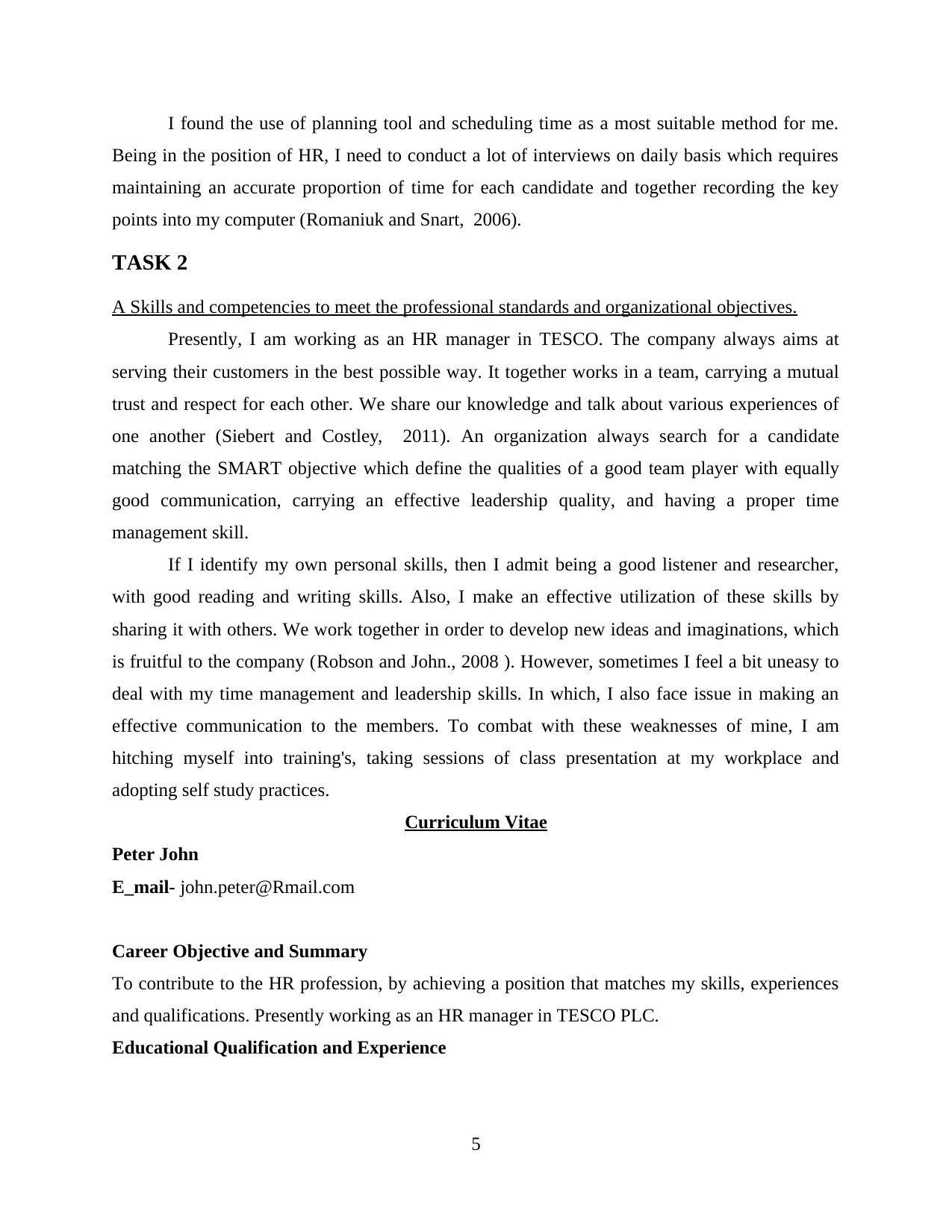
I found the use of planning tool and scheduling time as a most suitable method for me.
Being in the position of HR, I need to conduct a lot of interviews on daily basis which requires
maintaining an accurate proportion of time for each candidate and together recording the key
points into my computer (Romaniuk and Snart, 2006).
TASK 2
A Skills and competencies to meet the professional standards and organizational objectives.
Presently, I am working as an HR manager in TESCO. The company always aims at
serving their customers in the best possible way. It together works in a team, carrying a mutual
trust and respect for each other. We share our knowledge and talk about various experiences of
one another (Siebert and Costley, 2011). An organization always search for a candidate
matching the SMART objective which define the qualities of a good team player with equally
good communication, carrying an effective leadership quality, and having a proper time
management skill.
If I identify my own personal skills, then I admit being a good listener and researcher,
with good reading and writing skills. Also, I make an effective utilization of these skills by
sharing it with others. We work together in order to develop new ideas and imaginations, which
is fruitful to the company (Robson and John., 2008 ). However, sometimes I feel a bit uneasy to
deal with my time management and leadership skills. In which, I also face issue in making an
effective communication to the members. To combat with these weaknesses of mine, I am
hitching myself into training's, taking sessions of class presentation at my workplace and
adopting self study practices.
Curriculum Vitae
Peter John
E_mail- john.peter@Rmail.com
Career Objective and Summary
To contribute to the HR profession, by achieving a position that matches my skills, experiences
and qualifications. Presently working as an HR manager in TESCO PLC.
Educational Qualification and Experience
5
Being in the position of HR, I need to conduct a lot of interviews on daily basis which requires
maintaining an accurate proportion of time for each candidate and together recording the key
points into my computer (Romaniuk and Snart, 2006).
TASK 2
A Skills and competencies to meet the professional standards and organizational objectives.
Presently, I am working as an HR manager in TESCO. The company always aims at
serving their customers in the best possible way. It together works in a team, carrying a mutual
trust and respect for each other. We share our knowledge and talk about various experiences of
one another (Siebert and Costley, 2011). An organization always search for a candidate
matching the SMART objective which define the qualities of a good team player with equally
good communication, carrying an effective leadership quality, and having a proper time
management skill.
If I identify my own personal skills, then I admit being a good listener and researcher,
with good reading and writing skills. Also, I make an effective utilization of these skills by
sharing it with others. We work together in order to develop new ideas and imaginations, which
is fruitful to the company (Robson and John., 2008 ). However, sometimes I feel a bit uneasy to
deal with my time management and leadership skills. In which, I also face issue in making an
effective communication to the members. To combat with these weaknesses of mine, I am
hitching myself into training's, taking sessions of class presentation at my workplace and
adopting self study practices.
Curriculum Vitae
Peter John
E_mail- john.peter@Rmail.com
Career Objective and Summary
To contribute to the HR profession, by achieving a position that matches my skills, experiences
and qualifications. Presently working as an HR manager in TESCO PLC.
Educational Qualification and Experience
5
Paraphrase This Document
Need a fresh take? Get an instant paraphrase of this document with our AI Paraphraser
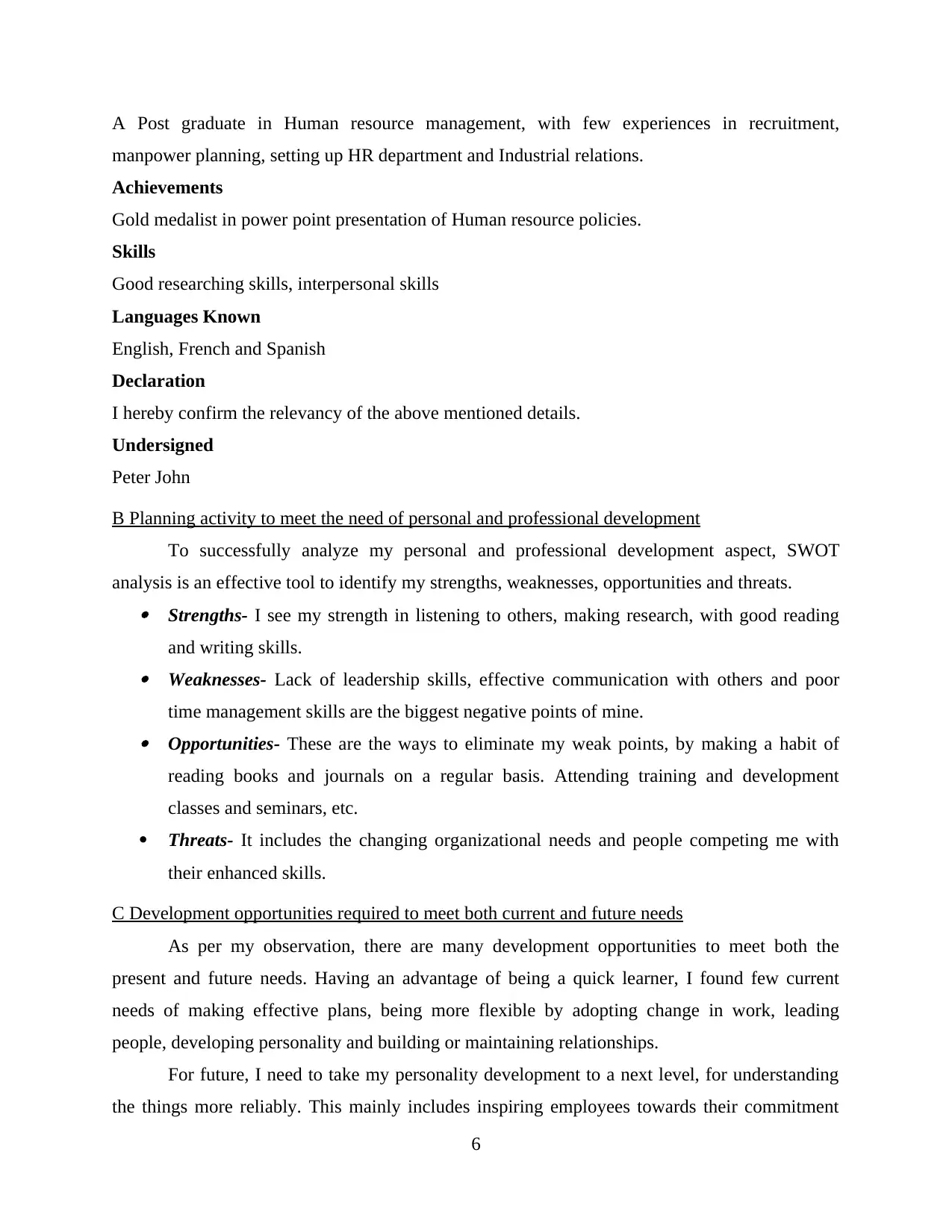
A Post graduate in Human resource management, with few experiences in recruitment,
manpower planning, setting up HR department and Industrial relations.
Achievements
Gold medalist in power point presentation of Human resource policies.
Skills
Good researching skills, interpersonal skills
Languages Known
English, French and Spanish
Declaration
I hereby confirm the relevancy of the above mentioned details.
Undersigned
Peter John
B Planning activity to meet the need of personal and professional development
To successfully analyze my personal and professional development aspect, SWOT
analysis is an effective tool to identify my strengths, weaknesses, opportunities and threats. Strengths- I see my strength in listening to others, making research, with good reading
and writing skills. Weaknesses- Lack of leadership skills, effective communication with others and poor
time management skills are the biggest negative points of mine. Opportunities- These are the ways to eliminate my weak points, by making a habit of
reading books and journals on a regular basis. Attending training and development
classes and seminars, etc.
Threats- It includes the changing organizational needs and people competing me with
their enhanced skills.
C Development opportunities required to meet both current and future needs
As per my observation, there are many development opportunities to meet both the
present and future needs. Having an advantage of being a quick learner, I found few current
needs of making effective plans, being more flexible by adopting change in work, leading
people, developing personality and building or maintaining relationships.
For future, I need to take my personality development to a next level, for understanding
the things more reliably. This mainly includes inspiring employees towards their commitment
6
manpower planning, setting up HR department and Industrial relations.
Achievements
Gold medalist in power point presentation of Human resource policies.
Skills
Good researching skills, interpersonal skills
Languages Known
English, French and Spanish
Declaration
I hereby confirm the relevancy of the above mentioned details.
Undersigned
Peter John
B Planning activity to meet the need of personal and professional development
To successfully analyze my personal and professional development aspect, SWOT
analysis is an effective tool to identify my strengths, weaknesses, opportunities and threats. Strengths- I see my strength in listening to others, making research, with good reading
and writing skills. Weaknesses- Lack of leadership skills, effective communication with others and poor
time management skills are the biggest negative points of mine. Opportunities- These are the ways to eliminate my weak points, by making a habit of
reading books and journals on a regular basis. Attending training and development
classes and seminars, etc.
Threats- It includes the changing organizational needs and people competing me with
their enhanced skills.
C Development opportunities required to meet both current and future needs
As per my observation, there are many development opportunities to meet both the
present and future needs. Having an advantage of being a quick learner, I found few current
needs of making effective plans, being more flexible by adopting change in work, leading
people, developing personality and building or maintaining relationships.
For future, I need to take my personality development to a next level, for understanding
the things more reliably. This mainly includes inspiring employees towards their commitment
6
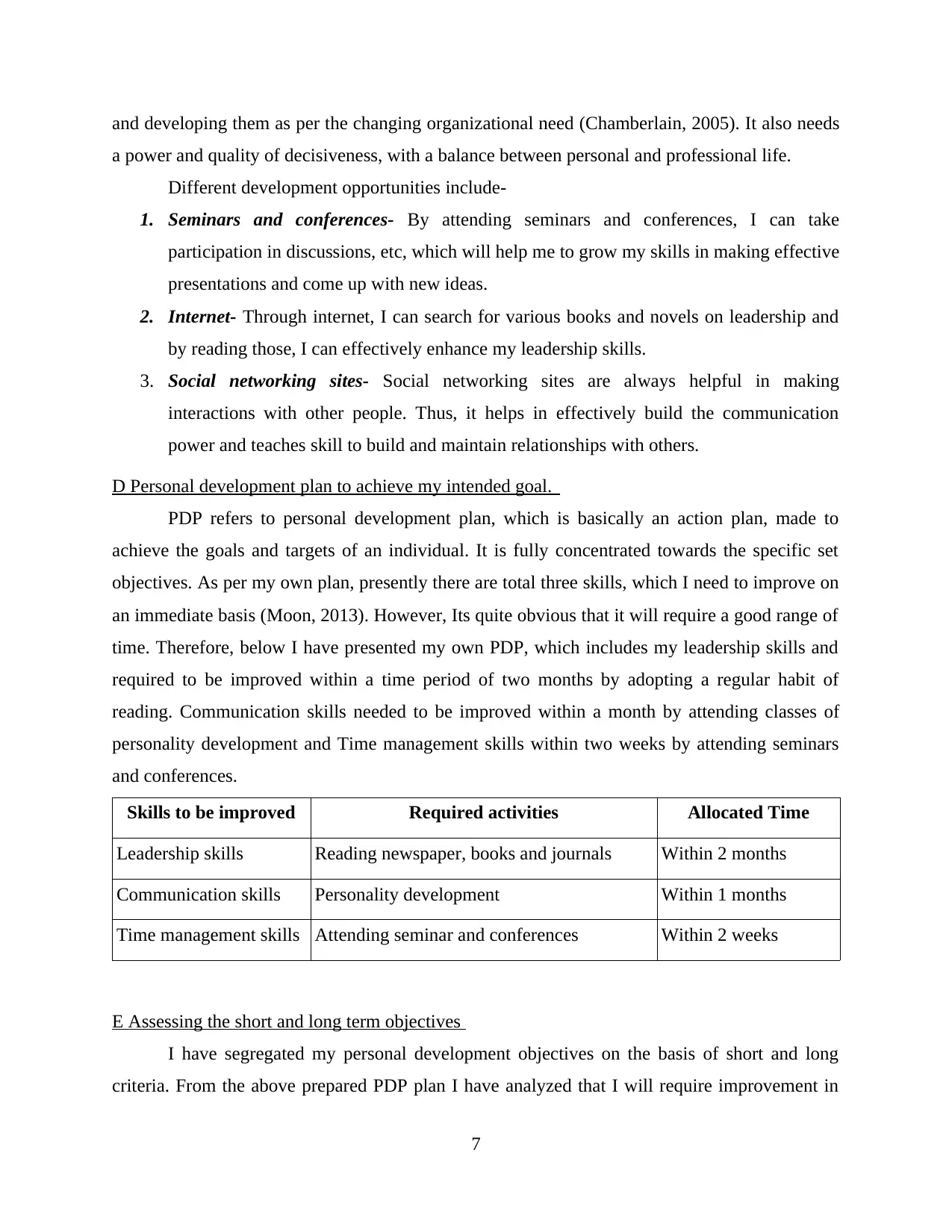
and developing them as per the changing organizational need (Chamberlain, 2005). It also needs
a power and quality of decisiveness, with a balance between personal and professional life.
Different development opportunities include-
1. Seminars and conferences- By attending seminars and conferences, I can take
participation in discussions, etc, which will help me to grow my skills in making effective
presentations and come up with new ideas.
2. Internet- Through internet, I can search for various books and novels on leadership and
by reading those, I can effectively enhance my leadership skills.
3. Social networking sites- Social networking sites are always helpful in making
interactions with other people. Thus, it helps in effectively build the communication
power and teaches skill to build and maintain relationships with others.
D Personal development plan to achieve my intended goal.
PDP refers to personal development plan, which is basically an action plan, made to
achieve the goals and targets of an individual. It is fully concentrated towards the specific set
objectives. As per my own plan, presently there are total three skills, which I need to improve on
an immediate basis (Moon, 2013). However, Its quite obvious that it will require a good range of
time. Therefore, below I have presented my own PDP, which includes my leadership skills and
required to be improved within a time period of two months by adopting a regular habit of
reading. Communication skills needed to be improved within a month by attending classes of
personality development and Time management skills within two weeks by attending seminars
and conferences.
Skills to be improved Required activities Allocated Time
Leadership skills Reading newspaper, books and journals Within 2 months
Communication skills Personality development Within 1 months
Time management skills Attending seminar and conferences Within 2 weeks
E Assessing the short and long term objectives
I have segregated my personal development objectives on the basis of short and long
criteria. From the above prepared PDP plan I have analyzed that I will require improvement in
7
a power and quality of decisiveness, with a balance between personal and professional life.
Different development opportunities include-
1. Seminars and conferences- By attending seminars and conferences, I can take
participation in discussions, etc, which will help me to grow my skills in making effective
presentations and come up with new ideas.
2. Internet- Through internet, I can search for various books and novels on leadership and
by reading those, I can effectively enhance my leadership skills.
3. Social networking sites- Social networking sites are always helpful in making
interactions with other people. Thus, it helps in effectively build the communication
power and teaches skill to build and maintain relationships with others.
D Personal development plan to achieve my intended goal.
PDP refers to personal development plan, which is basically an action plan, made to
achieve the goals and targets of an individual. It is fully concentrated towards the specific set
objectives. As per my own plan, presently there are total three skills, which I need to improve on
an immediate basis (Moon, 2013). However, Its quite obvious that it will require a good range of
time. Therefore, below I have presented my own PDP, which includes my leadership skills and
required to be improved within a time period of two months by adopting a regular habit of
reading. Communication skills needed to be improved within a month by attending classes of
personality development and Time management skills within two weeks by attending seminars
and conferences.
Skills to be improved Required activities Allocated Time
Leadership skills Reading newspaper, books and journals Within 2 months
Communication skills Personality development Within 1 months
Time management skills Attending seminar and conferences Within 2 weeks
E Assessing the short and long term objectives
I have segregated my personal development objectives on the basis of short and long
criteria. From the above prepared PDP plan I have analyzed that I will require improvement in
7
⊘ This is a preview!⊘
Do you want full access?
Subscribe today to unlock all pages.

Trusted by 1+ million students worldwide
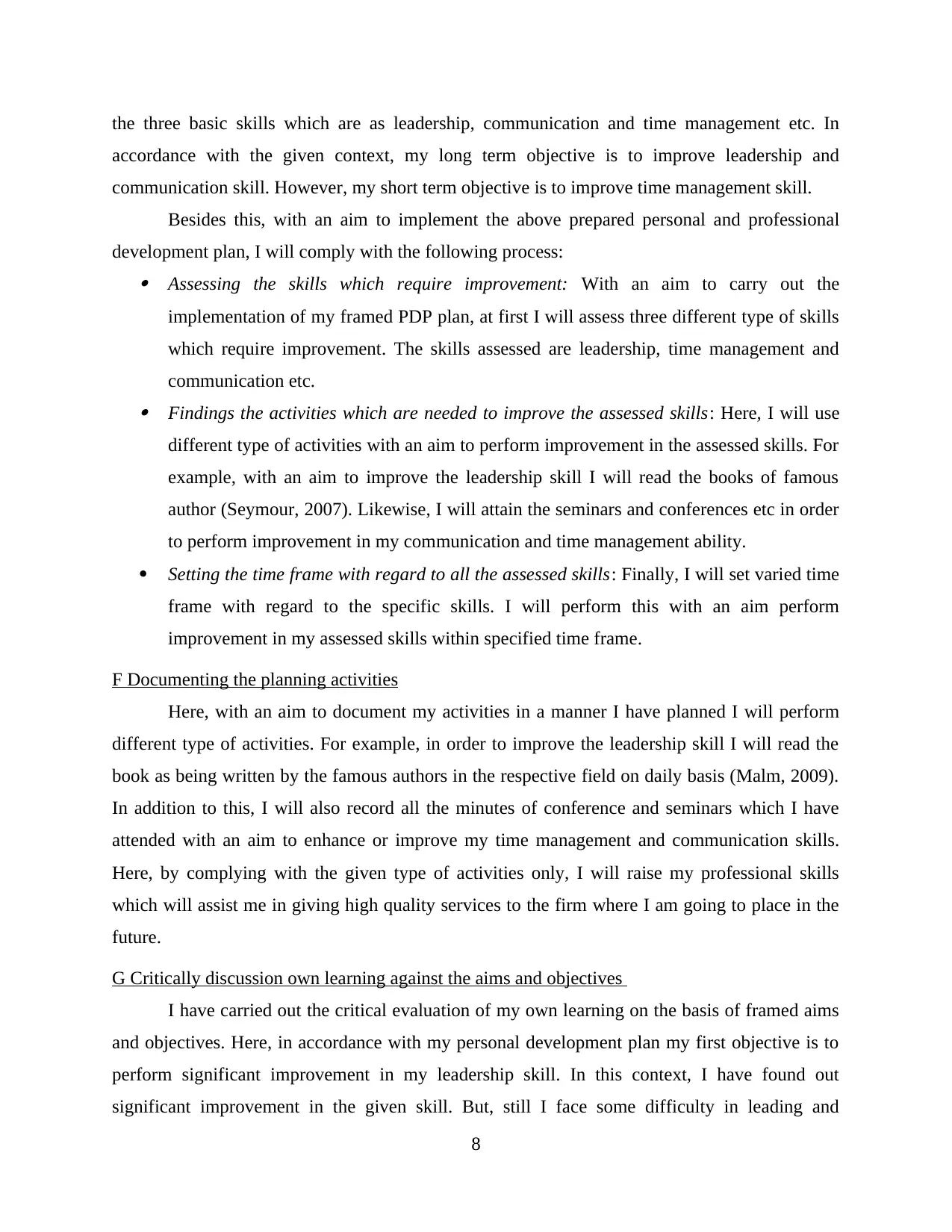
the three basic skills which are as leadership, communication and time management etc. In
accordance with the given context, my long term objective is to improve leadership and
communication skill. However, my short term objective is to improve time management skill.
Besides this, with an aim to implement the above prepared personal and professional
development plan, I will comply with the following process: Assessing the skills which require improvement: With an aim to carry out the
implementation of my framed PDP plan, at first I will assess three different type of skills
which require improvement. The skills assessed are leadership, time management and
communication etc. Findings the activities which are needed to improve the assessed skills: Here, I will use
different type of activities with an aim to perform improvement in the assessed skills. For
example, with an aim to improve the leadership skill I will read the books of famous
author (Seymour, 2007). Likewise, I will attain the seminars and conferences etc in order
to perform improvement in my communication and time management ability.
Setting the time frame with regard to all the assessed skills: Finally, I will set varied time
frame with regard to the specific skills. I will perform this with an aim perform
improvement in my assessed skills within specified time frame.
F Documenting the planning activities
Here, with an aim to document my activities in a manner I have planned I will perform
different type of activities. For example, in order to improve the leadership skill I will read the
book as being written by the famous authors in the respective field on daily basis (Malm, 2009).
In addition to this, I will also record all the minutes of conference and seminars which I have
attended with an aim to enhance or improve my time management and communication skills.
Here, by complying with the given type of activities only, I will raise my professional skills
which will assist me in giving high quality services to the firm where I am going to place in the
future.
G Critically discussion own learning against the aims and objectives
I have carried out the critical evaluation of my own learning on the basis of framed aims
and objectives. Here, in accordance with my personal development plan my first objective is to
perform significant improvement in my leadership skill. In this context, I have found out
significant improvement in the given skill. But, still I face some difficulty in leading and
8
accordance with the given context, my long term objective is to improve leadership and
communication skill. However, my short term objective is to improve time management skill.
Besides this, with an aim to implement the above prepared personal and professional
development plan, I will comply with the following process: Assessing the skills which require improvement: With an aim to carry out the
implementation of my framed PDP plan, at first I will assess three different type of skills
which require improvement. The skills assessed are leadership, time management and
communication etc. Findings the activities which are needed to improve the assessed skills: Here, I will use
different type of activities with an aim to perform improvement in the assessed skills. For
example, with an aim to improve the leadership skill I will read the books of famous
author (Seymour, 2007). Likewise, I will attain the seminars and conferences etc in order
to perform improvement in my communication and time management ability.
Setting the time frame with regard to all the assessed skills: Finally, I will set varied time
frame with regard to the specific skills. I will perform this with an aim perform
improvement in my assessed skills within specified time frame.
F Documenting the planning activities
Here, with an aim to document my activities in a manner I have planned I will perform
different type of activities. For example, in order to improve the leadership skill I will read the
book as being written by the famous authors in the respective field on daily basis (Malm, 2009).
In addition to this, I will also record all the minutes of conference and seminars which I have
attended with an aim to enhance or improve my time management and communication skills.
Here, by complying with the given type of activities only, I will raise my professional skills
which will assist me in giving high quality services to the firm where I am going to place in the
future.
G Critically discussion own learning against the aims and objectives
I have carried out the critical evaluation of my own learning on the basis of framed aims
and objectives. Here, in accordance with my personal development plan my first objective is to
perform significant improvement in my leadership skill. In this context, I have found out
significant improvement in the given skill. But, still I face some difficulty in leading and
8
Paraphrase This Document
Need a fresh take? Get an instant paraphrase of this document with our AI Paraphraser
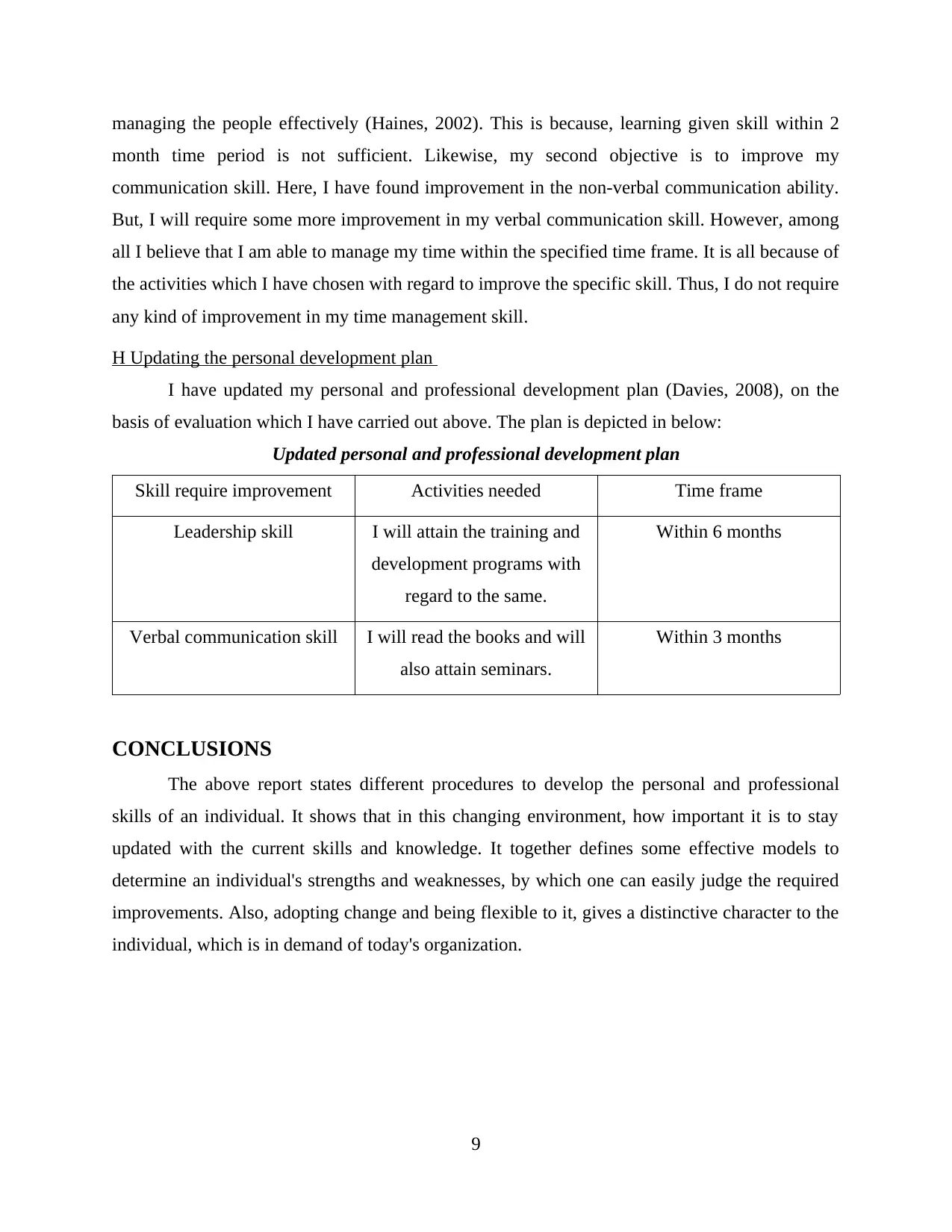
managing the people effectively (Haines, 2002). This is because, learning given skill within 2
month time period is not sufficient. Likewise, my second objective is to improve my
communication skill. Here, I have found improvement in the non-verbal communication ability.
But, I will require some more improvement in my verbal communication skill. However, among
all I believe that I am able to manage my time within the specified time frame. It is all because of
the activities which I have chosen with regard to improve the specific skill. Thus, I do not require
any kind of improvement in my time management skill.
H Updating the personal development plan
I have updated my personal and professional development plan (Davies, 2008), on the
basis of evaluation which I have carried out above. The plan is depicted in below:
Updated personal and professional development plan
Skill require improvement Activities needed Time frame
Leadership skill I will attain the training and
development programs with
regard to the same.
Within 6 months
Verbal communication skill I will read the books and will
also attain seminars.
Within 3 months
CONCLUSIONS
The above report states different procedures to develop the personal and professional
skills of an individual. It shows that in this changing environment, how important it is to stay
updated with the current skills and knowledge. It together defines some effective models to
determine an individual's strengths and weaknesses, by which one can easily judge the required
improvements. Also, adopting change and being flexible to it, gives a distinctive character to the
individual, which is in demand of today's organization.
9
month time period is not sufficient. Likewise, my second objective is to improve my
communication skill. Here, I have found improvement in the non-verbal communication ability.
But, I will require some more improvement in my verbal communication skill. However, among
all I believe that I am able to manage my time within the specified time frame. It is all because of
the activities which I have chosen with regard to improve the specific skill. Thus, I do not require
any kind of improvement in my time management skill.
H Updating the personal development plan
I have updated my personal and professional development plan (Davies, 2008), on the
basis of evaluation which I have carried out above. The plan is depicted in below:
Updated personal and professional development plan
Skill require improvement Activities needed Time frame
Leadership skill I will attain the training and
development programs with
regard to the same.
Within 6 months
Verbal communication skill I will read the books and will
also attain seminars.
Within 3 months
CONCLUSIONS
The above report states different procedures to develop the personal and professional
skills of an individual. It shows that in this changing environment, how important it is to stay
updated with the current skills and knowledge. It together defines some effective models to
determine an individual's strengths and weaknesses, by which one can easily judge the required
improvements. Also, adopting change and being flexible to it, gives a distinctive character to the
individual, which is in demand of today's organization.
9
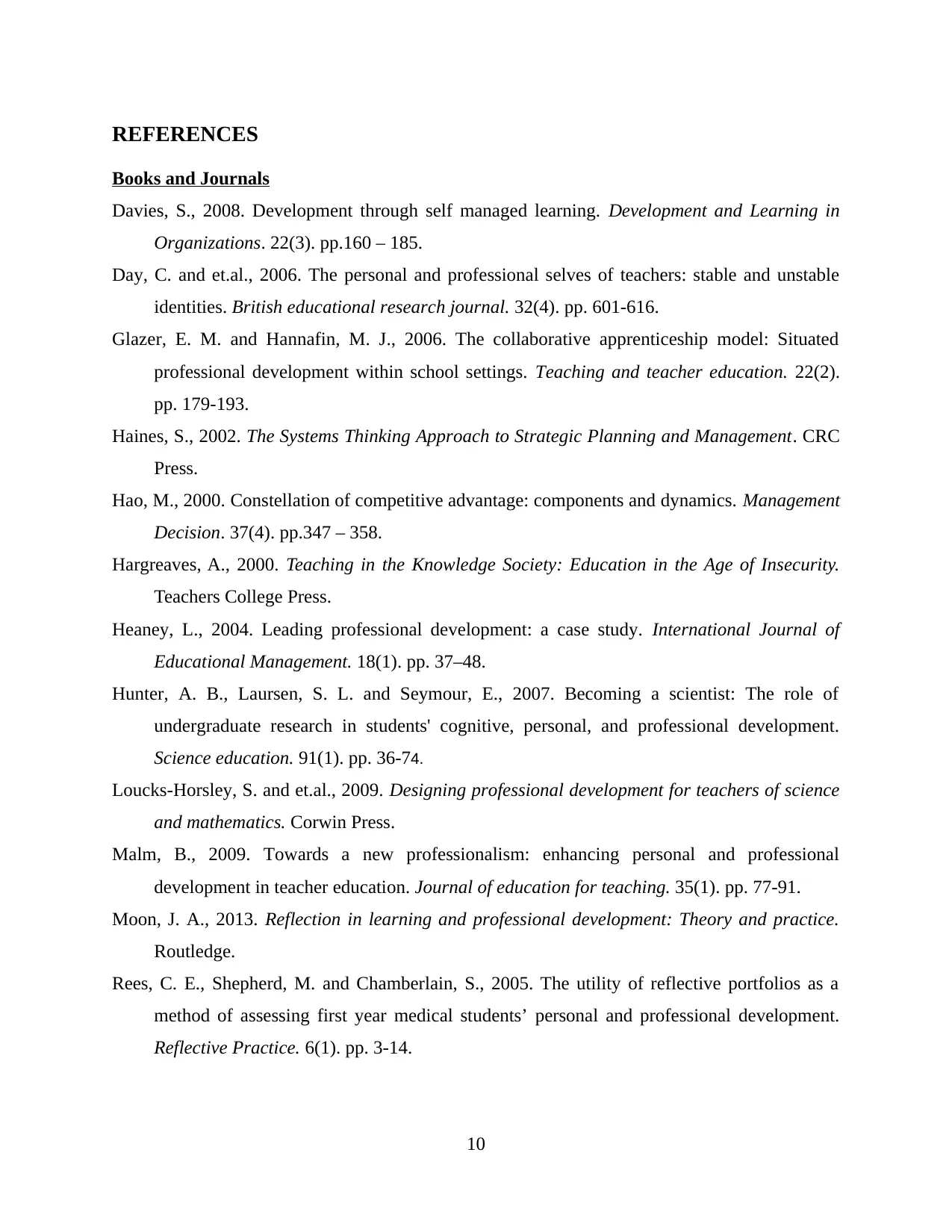
REFERENCES
Books and Journals
Davies, S., 2008. Development through self managed learning. Development and Learning in
Organizations. 22(3). pp.160 – 185.
Day, C. and et.al., 2006. The personal and professional selves of teachers: stable and unstable
identities. British educational research journal. 32(4). pp. 601-616.
Glazer, E. M. and Hannafin, M. J., 2006. The collaborative apprenticeship model: Situated
professional development within school settings. Teaching and teacher education. 22(2).
pp. 179-193.
Haines, S., 2002. The Systems Thinking Approach to Strategic Planning and Management. CRC
Press.
Hao, M., 2000. Constellation of competitive advantage: components and dynamics. Management
Decision. 37(4). pp.347 – 358.
Hargreaves, A., 2000. Teaching in the Knowledge Society: Education in the Age of Insecurity.
Teachers College Press.
Heaney, L., 2004. Leading professional development: a case study. International Journal of
Educational Management. 18(1). pp. 37–48.
Hunter, A. B., Laursen, S. L. and Seymour, E., 2007. Becoming a scientist: The role of
undergraduate research in students' cognitive, personal, and professional development.
Science education. 91(1). pp. 36-74.
Loucks-Horsley, S. and et.al., 2009. Designing professional development for teachers of science
and mathematics. Corwin Press.
Malm, B., 2009. Towards a new professionalism: enhancing personal and professional
development in teacher education. Journal of education for teaching. 35(1). pp. 77-91.
Moon, J. A., 2013. Reflection in learning and professional development: Theory and practice.
Routledge.
Rees, C. E., Shepherd, M. and Chamberlain, S., 2005. The utility of reflective portfolios as a
method of assessing first year medical students’ personal and professional development.
Reflective Practice. 6(1). pp. 3-14.
10
Books and Journals
Davies, S., 2008. Development through self managed learning. Development and Learning in
Organizations. 22(3). pp.160 – 185.
Day, C. and et.al., 2006. The personal and professional selves of teachers: stable and unstable
identities. British educational research journal. 32(4). pp. 601-616.
Glazer, E. M. and Hannafin, M. J., 2006. The collaborative apprenticeship model: Situated
professional development within school settings. Teaching and teacher education. 22(2).
pp. 179-193.
Haines, S., 2002. The Systems Thinking Approach to Strategic Planning and Management. CRC
Press.
Hao, M., 2000. Constellation of competitive advantage: components and dynamics. Management
Decision. 37(4). pp.347 – 358.
Hargreaves, A., 2000. Teaching in the Knowledge Society: Education in the Age of Insecurity.
Teachers College Press.
Heaney, L., 2004. Leading professional development: a case study. International Journal of
Educational Management. 18(1). pp. 37–48.
Hunter, A. B., Laursen, S. L. and Seymour, E., 2007. Becoming a scientist: The role of
undergraduate research in students' cognitive, personal, and professional development.
Science education. 91(1). pp. 36-74.
Loucks-Horsley, S. and et.al., 2009. Designing professional development for teachers of science
and mathematics. Corwin Press.
Malm, B., 2009. Towards a new professionalism: enhancing personal and professional
development in teacher education. Journal of education for teaching. 35(1). pp. 77-91.
Moon, J. A., 2013. Reflection in learning and professional development: Theory and practice.
Routledge.
Rees, C. E., Shepherd, M. and Chamberlain, S., 2005. The utility of reflective portfolios as a
method of assessing first year medical students’ personal and professional development.
Reflective Practice. 6(1). pp. 3-14.
10
⊘ This is a preview!⊘
Do you want full access?
Subscribe today to unlock all pages.

Trusted by 1+ million students worldwide
1 out of 13
Related Documents
Your All-in-One AI-Powered Toolkit for Academic Success.
+13062052269
info@desklib.com
Available 24*7 on WhatsApp / Email
![[object Object]](/_next/static/media/star-bottom.7253800d.svg)
Unlock your academic potential
Copyright © 2020–2025 A2Z Services. All Rights Reserved. Developed and managed by ZUCOL.





